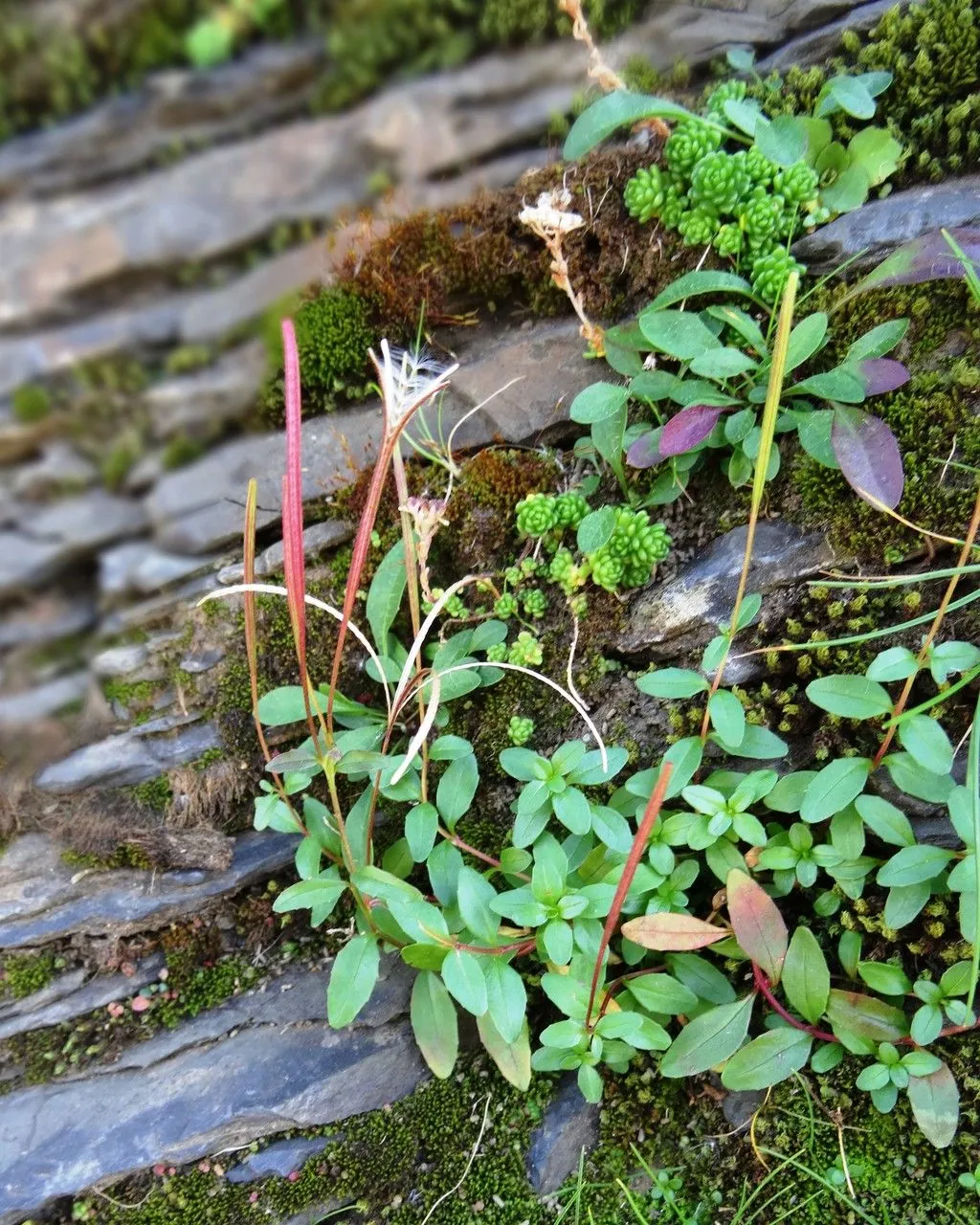
Author: Lam.
Bibliography: Encycl. 2: 376 (1786)
Year: 1786
Status: accepted
Rank: species
Genus: Epilobium
Vegetable: False
Observations: Subarctic & Temp. Northern Hemisphere
Pimpernel willowherb, scientifically known as Epilobium anagallidifolium, is an intriguing plant species belonging to the Onagraceae family. This particular willowherb was first officially recorded in “Encycl. 2: 376” back in 1786 thanks to the work of the esteemed botanist Lam.
Native to the subarctic and temperate regions of the Northern Hemisphere, Pimpernel willowherb thrives in cooler climates where it has adapted to survive and flourish. Its habitat straddles a variety of environments, typically favoring moist, open areas such as meadows and alongside streams where it can take advantage of the ample moisture.
Visually, Pimpernel willowherb captures attention with its delicate structure. The plant sports slender, erect stems that are often tinged with shades of green or red, adorned with small, ovate leaves that are reminiscent of those found on the pimpernel plant—hence the name. Further enhancing its appeal, this willowherb species produces small, yet striking flowers that contribute to the biodiversity of the regions it inhabits.
The pimpernel willowherb is not just notable for its beauty; it also plays a crucial role in its ecosystem. It provides support to various pollinators and contributes to the overall health of its natural environment, highlighting the importance of preserving such native species in our increasingly changing world.
In conclusion, the Pimpernel willowherb (Epilobium anagallidifolium) is a noteworthy member of the Onagraceae family, with a historical botanical background and a significant presence in subarctic and temperate regions of the Northern Hemisphere. Its delicate appearance and ecological importance underline the value of this plant both in scientific study and environmental conservation.
Deu: gauchheil-weidenröschen, gauchheilblättriges weidenröschen
Eng: pimpernel willowherb, alpine willowherb
Nob: dvergmjølke
Nno: dvergmjølke
Swe: dvärgdunört, tunturihorsma
Fin: tunturihorsma
Sme: duottarhorbmá
Fra: épilobe à feuilles de mouron, épilobe à feuilles d’anagallide
Cym: helyglys mynyddig, helyglys y mynydd
En: Pimpernel willowherb, Dwarf fireweed, Alpine willowherb, Alpine willowweed
Bg: Алпийска върбовка
Ca: Epilobi alpí
Zh: 新疆柳叶菜
Cs: Vrbovka drchničkolistá
Fi: Tunturihorsma
Fr: Épilobe à feuilles de mouron, Épilobe à feuilles d’anagallide
De: Alpen-Weidenröschen, Gauchheil-Weidenröschen, Gauchheilblättriges Weidenröschen
It: Garofanino alpino
Se: Duottarhorbmá
Nb: Dvergmjølke
Nn: Dvergmjølke
Fa: علف خر برگباریک
Sv: Dvärgdunört, Tunturihorsma
Uk: Зніт курячоочковий
Cy: Helyglys y mynydd, Helyglys Mynyddig
© copyright of the Board of Trustees of the Royal Botanic Gardens, Kew.
© copyright of the Board of Trustees of the Royal Botanic Gardens, Kew.
© copyright of the Board of Trustees of the Royal Botanic Gardens, Kew.
Taken Sep 4, 2005 by Tela Botanica − Alain BIGOU (cc-by-sa)
Taken Aug 21, 2014 by Tela Botanica − Jean-Luc Gorremans (cc-by-sa)
Taken Jul 19, 2015 by Tela Botanica − Martine MARTHOURET ROBERT (cc-by-sa)
Taken Jul 2, 2022 by eric buffard (cc-by-sa)
Taken Aug 26, 2020 by Alain Bigou (cc-by-sa)
Taken Oct 6, 2021 by Frédéric Faure (cc-by-sa)
Taken Aug 23, 2019 by Denis Bastianelli (cc-by-sa)
Taken May 5, 2020 by mel jon (cc-by-sa)
Taken Aug 26, 2020 by Alain Bigou (cc-by-sa)
Taken Aug 26, 2020 by Alain Bigou (cc-by-sa)
Taken Jul 1, 2022 by Rohweder Karsten (cc-by-sa)
Taken Aug 13, 2022 by Rohweder Karsten (cc-by-sa)
Taken Oct 13, 2022 by josef casutt (cc-by-sa)
Taken Sep 20, 2021 by marlbobbins (cc-by-sa)
Taken Aug 26, 2020 by Alain Bigou (cc-by-sa)
Taken Oct 6, 2021 by Frédéric Faure (cc-by-sa)
Taken Aug 23, 2019 by Denis Bastianelli (cc-by-sa)
Taken Oct 6, 2021 by Frédéric Faure (cc-by-sa)
Taken Sep 4, 2005 by Tela Botanica − Alain BIGOU (cc-by-sa)
Taken Aug 19, 2018 by Serena Schade (cc-by-sa)
Taken Aug 15, 2009 by Photoflora – Jean-Luc TASSET (©)
Taken Aug 15, 2005 by Photoflora – Jean-Luc TASSET (©)
Taken Jul 15, 2008 by Photoflora – Jean-Luc TASSET (©)
Taken Jul 15, 2014 by Photoflora – Benoit BOCK (©)
Taken Jan 1, 1970 by Photoflora – L’Abbé COSTE (©)
Growth habit: Forb/herb
Ph maximum: 6.5
Ph minimum: 5.5
Light: 8
Atmospheric humidity: 8
Bloom months: [‘jul’, ‘aug’]
Soil nutriments: 4
Family: Myrtaceae Author: (F.Muell.) K.D.Hill & L.A.S.Johnson Bibliography: Telopea 6: 402 (1995) Year: 1995 Status:…
Family: Rubiaceae Author: Pierre ex A.Froehner Bibliography: Notizbl. Bot. Gart. Berlin-Dahlem 1: 237 (1897) Year:…
Family: Sapindaceae Author: Koidz. Bibliography: J. Coll. Sci. Imp. Univ. Tokyo 32(1): 38 (1911) Year:…
Family: Asteraceae Author: A.Gray Bibliography: Pacif. Railr. Rep.: 107 (1857) Year: 1857 Status: accepted Rank:…
Family: Fabaceae Author: Medik. Bibliography: Vorles. Churpfälz. Phys.-Ökon. Ges. 2: 398 (1787) Year: 1787 Status:…
Family: Aspleniaceae Author: (Cav.) Alston Bibliography: Bull. Misc. Inform. Kew 1932: 309 (1932) Year: 1932…